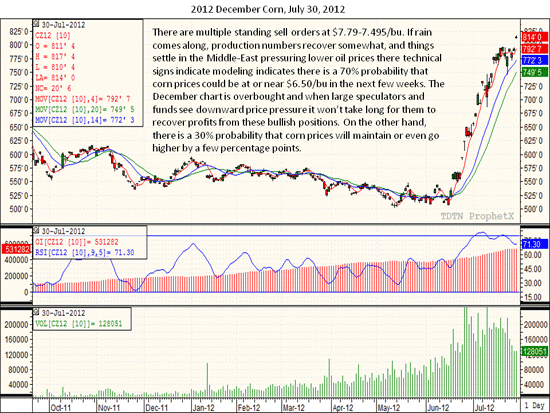



Weekly Roberts Market Report
US - The US House of Representatives is scheduled to vote this week on extending the current 2008 farm bill by one year in order to reinstate emergency drought and other aid for farmers and ranchers. Sources confirm that included in the proposal will be help for producers to deal with losses from widespread drought for corn and soybean production and elevated livestock prices, writes Michael Roberts.House Agriculture Committee Chairman Frank Lucas (R., Okla.) said Saturday that drought assistance measures would be revived in a one-year extension of the 2008 farm bill by cutting funding for subsidy programs. The 2008 farm bill is set to expire on September 30, 2012 there is some doubt whether or not there is enough support in the House to pass a new 2012 five-year farm bill. The Senate passed its version of the new 2012 farm bill on 21 June, but the House leadership has yet to schedule a vote on its own version. Mr Lucas said he is trying to get a House floor vote on the new 2012 farm bill his committee approved on July 12 that would reduce spending by $35 billion over 10 years by cutting agriculture subsidies, food-stamp spending and other programs. Both bodies of Congress must pass a version and then create a unified bill before it can be signed into law.
LEAN HOGS on the CME finished up on Monday with the exception of the nearby August contract. AUG’12LH futures finished $0.650/cwt lower at $94.65/cwt and $1.325/cwt lower than last Monday’s close. The DEC’12LH contract closed at $80.00/cwt; up $0.700/cwt and $3.950/cwt over last report. Seasonal trends and spillover from commodity markets were supportive. Pit sources said they expected the drought and rising feed costs to push producers to cut back on production tightening supplies of hogs into next year. Slightly higher sow culling was noted. Prices for breeding stock were under pressure at a number of local and regional markets last week and again on Monday. Quotes for sows ranged $1-$3/cwt lower. Some plant schedules have been trimmed due to hot worker conditions. Average slaughter weights were down 4 lbs/hd from a week ago to 271 lbs/hd. Average weights have declined due to hot weather over the last two weeks and are expected to erode further for another week or two. According to HedgersEdge.com, the average packer margin was raised $3.65/hd to a negative $3.65/head based on the average buy of $67.66/cwt vs. the breakeven of $66.40/cwt. Monday the CME lean hog index was estimated at 96.04; down 0.02 and 2.01 lower week before last.
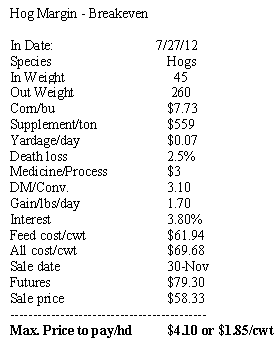
CORN futures on the Chicago Board of Trade (CBOT) finished up on Monday. The SEPT’12 contract closed at $8.200/bu; up 21.5¢/bu and 6.0¢/bu higher than last Monday’s close. The DEC’12 contract closed at $8.140/bu; up 20.75¢/bu and 28.75¢/bu over last report and established a new life-of-contract high. Continued drought concerns on dry forecasts amid uncertainty about the ultimate size of the crop were supportive. The drought categories of extreme and exceptional, as noted on the graphs below expanded 7 per cent last week. This is the highest level of drought affected acreage since 2003 and the largest weekly increase in the extreme and exceptional categories since Drought monitoring began in the US in January 2000. See US Drought Monitor graphs:

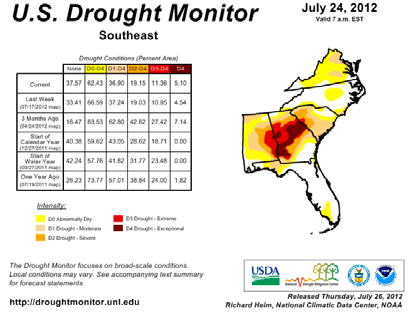
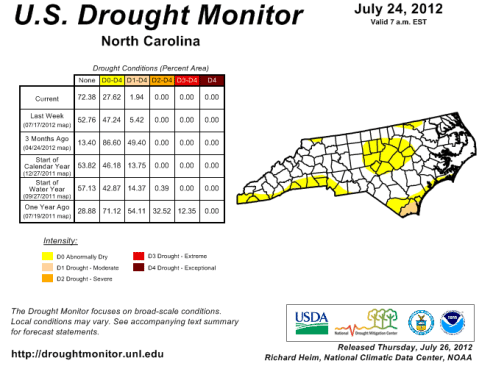
Reduced demand for US high-priced corn limited prices somewhat. Livestock industry representatives have asked the government to temporarily halt the ethanol-production mandate that forces much of the crop into fuel. While demand rationing is taking place strengthening inverse in futures spreads show that end users don’t believe it is enough to offset the expected large drop in production. Exports were bearish with USDA putting corn-inspected-for-export at 21.438 mb vs. estimates for 22-24 mb. This is well below the 35.5 mb needed to stay on pace with USDA’s 1.b bb demand projection. Please see graph.
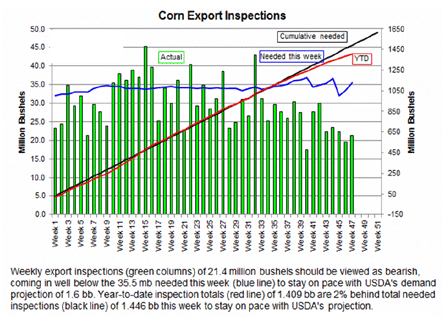
The national average basis for corn fell 1.0¢/bu to -10.0¢/bu compared to September futures. Basis in Central North Carolina was +50.0¢/bu and in Virginia -16.0¢/bu. Late Monday afternoon USDA put the US corn crop in good-to-excellent condition at 24 per cent vs. 26 per cent this time last week and 62 per cent this time last year.
SOYBEAN futures on the Chicago Board of Trade (CBOT) closed up on Monday. The AUG’12 contract closed at $17.256/bu; up 41.5¢/bu and 27.25¢/bu over last report. NOV’12 futures closed at $434/bu; up 41.75¢/bu and 21.15¢/bu higher than a week ago. Weather and traders adding risk premiums ahead of the USDA crop progress report were supportive. Soybeans are entering a crucial pod-setting/filling stage over the next few weeks. The crop is about two-weeks ahead of the normal production cycle due to early planting and heat stress. When plants are under stress they speed up the life cycle to reproduce before it dies. The National Weather Service forecasts mostly dry weather this week for the important soybean-growing states of Iowa, Illinois, and Missouri. High temperatures are expected to reach the upper 90s in Iowa and Illinois and low 100s in Missouri. Demand remains strong as China continues to import US soybeans due to low production in South America. Additionally, domestic soybean-meal demand for animal feed remains strong. Late Monday USDA put the US soybean crop in good-to-excellent condition at 29 per cent vs. 31 per cent last week and 60 per cent this time last year. The national average basis for soybeans fell 3.0¢/bu to -36.0¢/bu compared to August futures. Basis in Central North Carolina was -83.75¢/bu and in Virginia -61.75¢/bu. Exports were bullish. USDA put soybeans-inspected-for-export at 15.498 mb vs. estimates for 12-15 mb. Inspections are 78 mb ahead of the demand curve projected by USDA’s 1.34 bb for 2012. Please see graph:
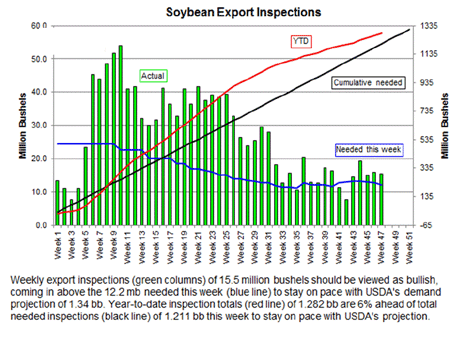
WHEAT futures in Chicago (CBOT) closed up on Monday. SEPT’12 wheat futures finished at $9.144/bu; up 16.5¢/bu and 1.75¢/bu over last report. The JULY’13 contract closed at $8.316/bu; up 1.5¢/bu and 21.25¢/bu higher than last Monday at this time. Spillover from corn and soybeans was supportive. Wheat prices are somewhat linked to these as wheat is also an animal feed. In addition, damage to wheat crops in other countries is becoming more apparent. Wheat crop damage from drought is surfacing from Australia and the Black Sea region. Too much rain is reportedly hurting wheat-crop prospects in Europe. Funds continue to be bullish on wheat as global supplies shrink. The national average basis for HRW wheat was down 1.0¢/bu to -55.0 compared to September futures. Late Monday USDA put the US wheat crop in good-to-excellent condition at 63 per cent vs. 60 per cent last week and 70 per cent this time last year. Exports are considered bearish as USDA put wheat-inspected-for-export at 18.601 mb vs. estimates for 19 - 21 mb. This is 5.199 mb short of the 23.8 mb needed to stay on pace with USDA’s 1.2 bb demand forecast.
